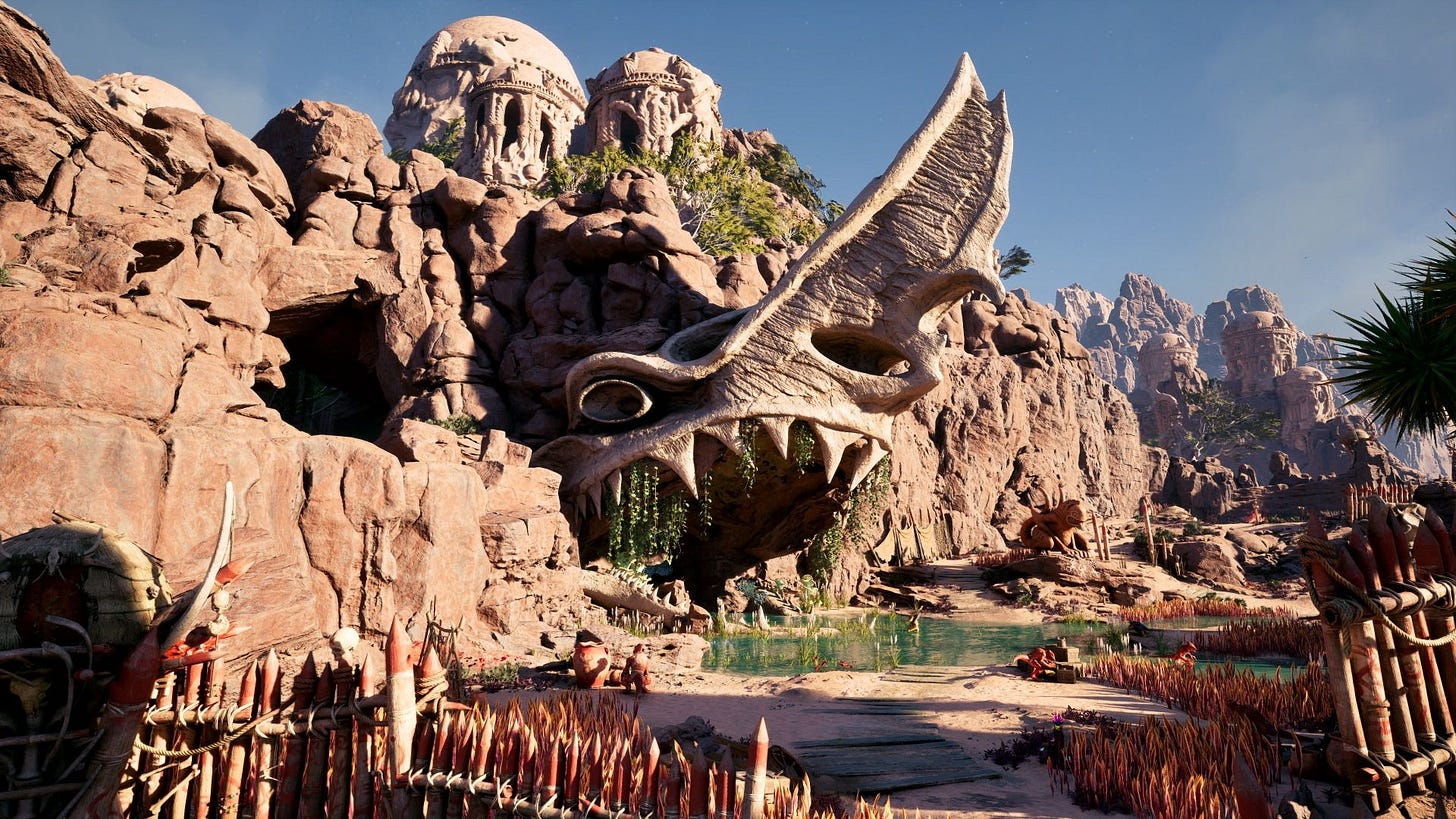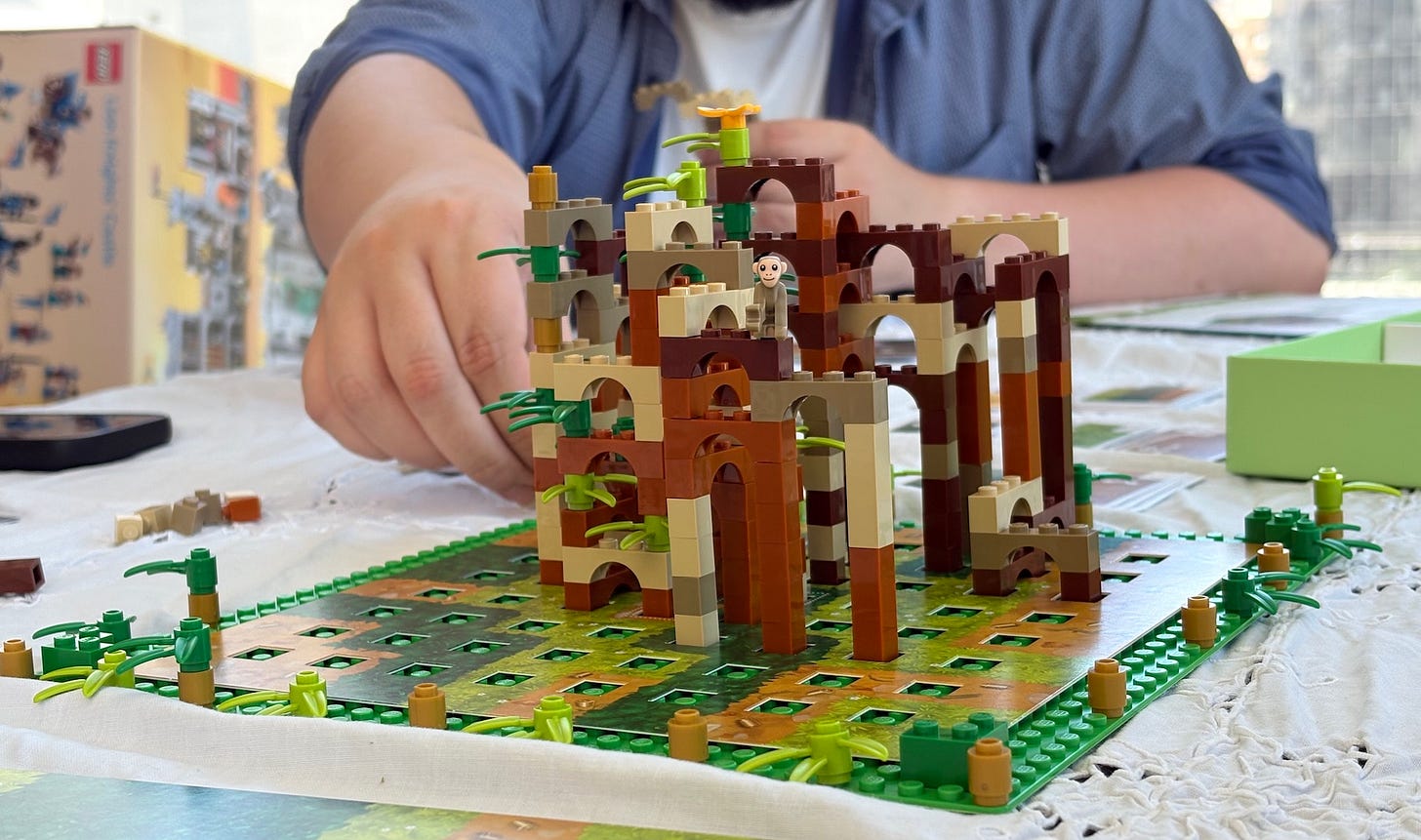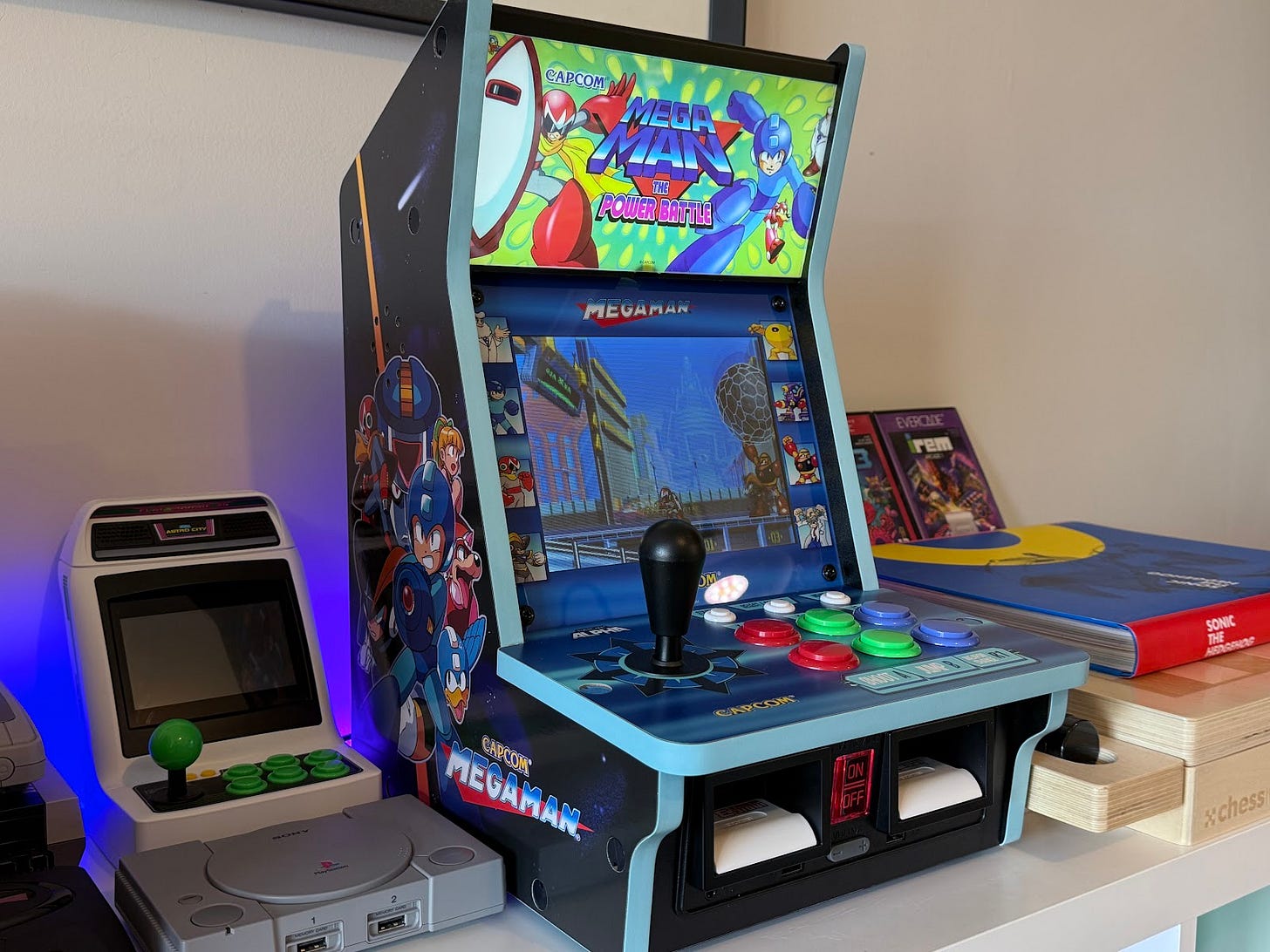Hello Button Buddies!
Happy Monday. I hope you all had a delightful weekend of gaming during the unseasonable cold patch.
This week Alice writes a love letter to an iconic Y2K aesthetic, and finds a game at the intersection of her specific interests (staircases and Lego), while Tim is excited about new Shinobi and gets an Evercade Alpha arcade machine. Plus, all the recommendations you need to get through the week.
Let’s get transparent
By Alice
The Y2K fashions are back, and as a millennial, it’s like looking back at all the fashion mistakes I made as a teen. Remember those black flared pants with chains hanging everywhere and the glow in the dark spiders on the thighs? They were a look, and now the youth are joyously wearing them in the streets. I’m happy that they at least get to enjoy the comfort of baggy jeans, as skinny jeans are an unkindness.
But alongside Nirvana shirts, tartan pants and an uncomfortable amount of mascara comes the good stuff for tech: Transparent everything. It’s the design aesthetic that should never have gone away.
I just got my new Xbox Design Lab 2nd Generation Elite controller in the mail, and it’s everything I would have wanted when I was 12, but can now only have as an adult who doesn’t have to ask their parents for stuff. The front plate is a transparent red, and it looks glorious. We can’t get back the clear home phones (well, we can, but no one would use them), and I think it’ll be a while before we get another transparent Xbox or N64, but anyone can make themselves a transparent controller right now, and I think that’s beautiful.
Gaming controllers seem to be the main area of tech that’s embracing transparent aesthetics. Backbone has a green smartphone controller, Xbox has a range of regular controllers that are transparent red or blue in addition to the Design Lab controllers and, if you stretch the meaning of “game controller” a bit, 8BitDo also has a transparent mechanical keyboard. I can only assume transparency is only limited because PC and smartphone makers are cowards.
On a related note, I am really loving the selection of customisations that the Xbox Design Lab has available at the moment. When it first launched, the options were a bit limited to just conventional colours, but now there are some more fun options with swirls, transparent plates in multiple colours, game-themed face plates, and chroma options for the D-Pad. There are even adaptive thumbstick toppers that you 3D print at home/local library to make it easier for people with disabilities to customise a controller to work for them.
What to play
Launching into Game Pass this week is Avowed, an RPG which I (Tim) have been playing for a few weeks and absolutely loving. It’s a lean design for a Skyrim-like, with a series of big levels that will take you around 50 hours to get through rather than a contiguous open world you could play forever. But it also eliminates a lot of the bloat and frustration that comes from big RPGs and stays fun throughout. The crunchy combat is a highlight, and I also dug the twisting fantasy narrative.
The PlayStation Plus Extra catalogue also gets some goodies this week, headlined by the very good Star Wars Jedi: Survivor. There’s also TopSpin 2K25, the first episode of Lost Records: Bloom & Rage (from the Life is Strange folks), the middling adventure mystery Somerville and SaGa Frontier Remastered, which is the latest example of Sony being very inconsistent when it comes to which games go in the regular catalogue and which go with the “classics” in the more expensive Deluxe. Speaking of which, Deluxe subscribers this week get Patapon 3 and the PS2’s Dropship: United Peace Force.
Free on the Epic Games Store this week is the Apex Legends: Loba Free Unlock Bundle. Apex Legends is already free, but this gives you access to a support Legend in a truly hideous outfit. So, that’s something. Her technical abilities are pretty decent, though, so it might be worth pushing through whatever they were thinking with that black, purple and white leopard print situation.
Who dat ninja
By Tim
The recent State of Play gave us our first decent look at Sega’s new Shinobi game, subtitled Art of Vengeance. It makes me sick to say it, but this is the first 2D game in the series for 30 years (!) and I’m very excited to see if it can live up to expectations. So after combing over the trailer several times, I have some observations.
This is Sega promoting the game, whereas five years ago it seemed to have no interest in putting its brand on Streets of Rage 4, a similar revival project. In that case, Sega licensed the brand to Dotemu, which collaborated with Guard Crush Games and Lizardcube to get it made. This time it looks like it’s just Sega and Lizardcube, which to be honest may not be an advantage. Streets of Rage 4 was a labour of love, this may be a corporation leveraging its IP.
Lizarcube’s only game previous to SoR4 was Wonder Boy: The Dragon’s Trap. All three games share the same wonderful hand-drawn art style, but since Wonder Boy attached the new art to the old Master System gameplay, and SoR had other devs helping with the combat, I’m wondering who’s actually building this.
Gameplay looks a lot more varied than the original series. We see sword combos, a grappling hook, climbing gear, a hookshot, a parachute and air dashing, plus the traditional shuriken. Are these unlockables? Can you return to earlier areas with them? Or are they standard parts of the toolkit?
Returning from Shinobi 3 are surfing levels and animal riding, but this time it looks like Joe Musashi has tamed a giant dog instead of a normal horse. We also see screen-clearing ninjutsu magic, which is a staple. Enemies have health meters, which is absolutely new.
Does this game have multiplayer? We only see Joe taking action in the trailer, but I noticed several conspicuous non-aggressors in the footage, including a young ninja with a ponytail and the same getup as Joe. Per the PR, Joe’s friends have all been turned to stone, so it’s possible these are hostages he’s rescued and revitalised. But co-op would be a welcome departure.
Obviously I have some reservations here, and I’m desperate to know who’s doing the soundtrack, but I’m also willing to give the benefit of the doubt at this early stage. Revenge of Shinobi and Shinobi 3 are some of the best side-scrolling action games of all time, and I would love a worthy follow-up this year.
Bricks, Boards and Beginnings
by Alice
Bricks, Boards, and Beginnings is a column about Lego, board games, and diversity in games. It’s (sadly) not often that one of these stories is about more than one of those themes, however today is a lucky day! There was a golden age of Lego board games roughly a decade ago. The toy company released dozens of titles where you built the board and then had lots of different ways to interact with it that you wouldn’t have been able to if it hadn’t been made of bricks. Then, one day, the shine seemed to have worn off Lego board games, they all got put in discount bins, and they stopped being as much of a thing.
But I’m pleased to report that the golden age seems to be coming back! Lego Monkey Kingdom is a brand new game where players have to build stairs to be the highest monkey and get the most bananas.
The set up is very simple: a large base plate, a cardboard cover that goes over the baseplate to hide or reveal certain start points and designate different colours for the start spots, then players collect a limited number of 1x1 bricks, arches and tall bricks to build their staircases. The colour of your starting area determines which points and parts you get at the end of your turn, and there will be times when it’s best to strategically skip a turn or two.
It’s simple enough that 8 year olds would have a good time with it, but there’s also enough strategy involved that my group of friends in our 30s really enjoyed it, and I’ve been thinking about playing it a lot since that day we tried it. It’s not the greatest Lego game of all time, but it’s certainly up there amongst the best. Certainly worth checking out if you’ve been missing brick-built games.
Retro Esoterica
by Tim
I recently picked up an Evercade Alpha, which is a compact arcade machine designed to sit on top of a bar or desk. They come in Mega Man or Street Fighter designs, are constructed with heavy wood and real arcade controls, and besides the built-in games you can plug in Evercade cartridges to play what you like. I got the Mega Man variant, partially because it looks cooler and I already have many ways to play Street Fighter (who knew there even were Mega Man arcade games?!), and partially because it’s the only Alpha unit I could find in stock in Australia.
I won’t get into the frankly disappointing state of the machine when I opened it, because I haven’t yet found out if it’s a quality control issue or a case of careless handling on the retailer or courier’s part. But something that’s absolutely on Blaze Entertainment (the maker of Evercade) is the bizarre decision to have a plastic layer protecting the screen that is screwed on and extends well into the body of the device. It’s that same kind of plastic that gets stuck behind screws on chairs from Fantastic Furniture, and I actually had to disassemble the arcade machine to get it all off.
Those frustrations aside, it’s a wonderful little machine that looks, plays and sounds great. The two included Mega Man games turn out to be boss rushes, where you choose an opponent on a roulette wheel and get their weapon when you defeat them, so you have to try to then guess an opponent who’ll be weak to your new gear. It’s surprisingly good. Also included are Strider, Final Fight, Knights of the Round and Carrier Air Wing.
For multiplayer you can attach USB controllers, and my wireless 8bitdo and Retro-bit pads worked a treat. Evercade cartridges are also seamless; I played R-Type from the IREM collection and wonderful modern jumpman-like Donut Dodo. The machine functions just like a VS or EXP, complete with the “game of the month” titles that arrive over Wi-Fi. Currently it’s a new Dig Dug clone starring a bomb-pooping rabbit.
As an at-home arcade machine I think the Alpha is solid, considering that at $420 it’s half the price of an Arcade1Up. It’s smaller, so you need an appropriately high place to put it. But it’s also easier to move around, and can be expanded with more games.







